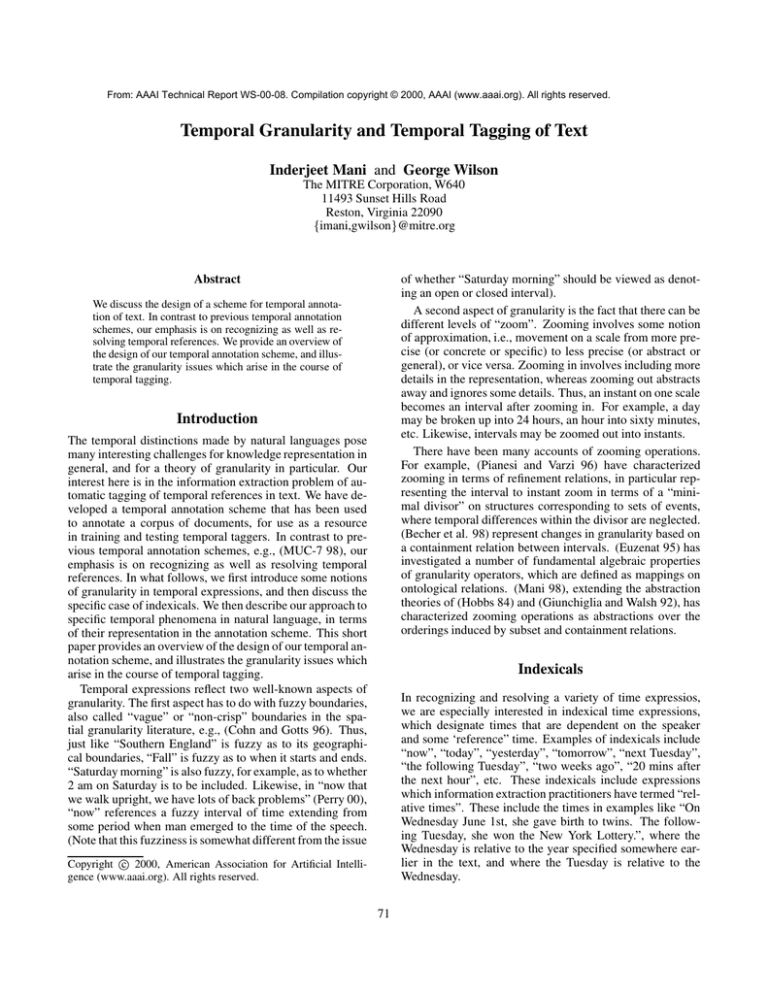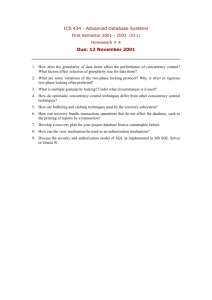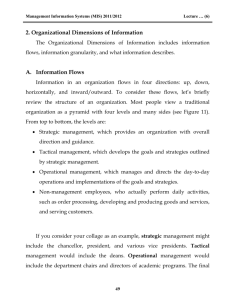
From: AAAI Technical Report WS-00-08. Compilation copyright © 2000, AAAI (www.aaai.org). All rights reserved.
Temporal Granularity and Temporal Tagging of Text
Inderjeet Mani and George Wilson
The MITRE Corporation, W640
11493 Sunset Hills Road
Reston, Virginia 22090
fimani,gwilsong@mitre.org
Abstract
of whether “Saturday morning” should be viewed as denoting an open or closed interval).
A second aspect of granularity is the fact that there can be
different levels of “zoom”. Zooming involves some notion
of approximation, i.e., movement on a scale from more precise (or concrete or specific) to less precise (or abstract or
general), or vice versa. Zooming in involves including more
details in the representation, whereas zooming out abstracts
away and ignores some details. Thus, an instant on one scale
becomes an interval after zooming in. For example, a day
may be broken up into 24 hours, an hour into sixty minutes,
etc. Likewise, intervals may be zoomed out into instants.
There have been many accounts of zooming operations.
For example, (Pianesi and Varzi 96) have characterized
zooming in terms of refinement relations, in particular representing the interval to instant zoom in terms of a “minimal divisor” on structures corresponding to sets of events,
where temporal differences within the divisor are neglected.
(Becher et al. 98) represent changes in granularity based on
a containment relation between intervals. (Euzenat 95) has
investigated a number of fundamental algebraic properties
of granularity operators, which are defined as mappings on
ontological relations. (Mani 98), extending the abstraction
theories of (Hobbs 84) and (Giunchiglia and Walsh 92), has
characterized zooming operations as abstractions over the
orderings induced by subset and containment relations.
We discuss the design of a scheme for temporal annotation of text. In contrast to previous temporal annotation
schemes, our emphasis is on recognizing as well as resolving temporal references. We provide an overview of
the design of our temporal annotation scheme, and illustrate the granularity issues which arise in the course of
temporal tagging.
Introduction
The temporal distinctions made by natural languages pose
many interesting challenges for knowledge representation in
general, and for a theory of granularity in particular. Our
interest here is in the information extraction problem of automatic tagging of temporal references in text. We have developed a temporal annotation scheme that has been used
to annotate a corpus of documents, for use as a resource
in training and testing temporal taggers. In contrast to previous temporal annotation schemes, e.g., (MUC-7 98), our
emphasis is on recognizing as well as resolving temporal
references. In what follows, we first introduce some notions
of granularity in temporal expressions, and then discuss the
specific case of indexicals. We then describe our approach to
specific temporal phenomena in natural language, in terms
of their representation in the annotation scheme. This short
paper provides an overview of the design of our temporal annotation scheme, and illustrates the granularity issues which
arise in the course of temporal tagging.
Temporal expressions reflect two well-known aspects of
granularity. The first aspect has to do with fuzzy boundaries,
also called “vague” or “non-crisp” boundaries in the spatial granularity literature, e.g., (Cohn and Gotts 96). Thus,
just like “Southern England” is fuzzy as to its geographical boundaries, “Fall” is fuzzy as to when it starts and ends.
“Saturday morning” is also fuzzy, for example, as to whether
2 am on Saturday is to be included. Likewise, in “now that
we walk upright, we have lots of back problems” (Perry 00),
“now” references a fuzzy interval of time extending from
some period when man emerged to the time of the speech.
(Note that this fuzziness is somewhat different from the issue
Indexicals
In recognizing and resolving a variety of time expressios,
we are especially interested in indexical time expressions,
which designate times that are dependent on the speaker
and some ‘reference” time. Examples of indexicals include
“now”, “today”, “yesterday”, “tomorrow”, “next Tuesday”,
“the following Tuesday”, “two weeks ago”, “20 mins after
the next hour”, etc. These indexicals include expressions
which information extraction practitioners have termed “relative times”. These include the times in examples like “On
Wednesday June 1st, she gave birth to twins. The following Tuesday, she won the New York Lottery.”, where the
Wednesday is relative to the year specified somewhere earlier in the text, and where the Tuesday is relative to the
Wednesday.
Copyright c 2000, American Association for Artificial Intelligence (www.aaai.org). All rights reserved.
71
Annotation Scheme
Cambodia but was not in Thailand, ending credence
to a claim <TIMEX TYPE=“DATE” val=“19971228”
val1=“19980103”>last week</TIMEX> the aged
and ailing former Khmer Rouge leader had fled to
China.</s>
Any annotation scheme should aim to be simple enough to
be executed efficiently and accurately by humans, and yet
precise enough for use in various natural language processing tasks. As in the (KSL-Time 99) ontology, time points are
represented on a time line, and intervals (which are treated
as sets of more than one time point) have start and end
points on the time line. In our case, however, the time line
is a calendric one (rather than the real number line), with
points on this calendric line characterized in terms of the
ISO standard CC:YY:MM:DD:HH:XX:SS, with an optional
time zone (ISO-8601 97). Since the goal of the tagging is to
resolve (rather than just recognize) temporal references, we
map temporal expressions to points or intervals in this calendric time line. In doing so, durative expressions like “from
3 pm to 6 pm” are tagged as intervals. So are non-durative
expressions which map to sets of more than one point on
the calendric line (e.g., “last week”, “the first three weeks in
November”). Other expressions which designate a point on
the calendric line are tagged as points. The ISO time spec
introduces several levels of “zoom” granularity, corresponding to each of the 7 units in the time spec.
Each temporal expression is tagged with a TIMEX tag, of
type TIME or DATE (the latter is inherited from the MUC7 spec). The tag has also a VAL attribute, which indicates
either starting time point in case of an interval, or the time
point otherwise. For example, “yesterday” will have as its
VAL the previous day’s date with respect to the reference
time. The VAL1 attribute references the end point in the
case of an interval. Both VAL and VAL1 are expressed in
the ISO time specification. The optional attribute OFFSET,
which also uses the ISO time specification, is used when
an indexical is expressed with an unknown reference time:
e.g., “the next day” may have an offset of 00:00:00:01 which
can be useful even if the reference time isn’t known. When
OFFSET is specified, DIRECTION (+ or -) is also specified.
It is worth noting that there are several kinds of temporal
expressions that are not to be tagged, and that other expressions tagged as a time expression are not assigned a value,
because doing so would violate the simplicity and preciseness requirements. We do not tag sets of intervals, like “the
first three days of every month”, unanchored intervals, such
as “half an hour (long)”, and event-dependent expressions,
like “five days after he came back”. Non-specific time expressions like generics, e.g., “April is usually wet”, or “today’s youth”, and indefinites, e.g., “a Tuesday”, are tagged
without a value, as are gapped intervals, e.g., “every Tuesday in 1999”, and expressions with vague quantifiers, e.g.,
“about three years ago”. Expressions that do refer to a specific time whose boundaries are indeterminate, e.g., “midday”, “Fall 1999”, are tagged as time expressions but are not
assigned a value. Finally, expressions which are ambiguous
without a strongly preferred reading are left untagged.
To convey a flavor of the annotation, here is an example
tagged sentence:
Granularity Patterns
In a given text, indexical time expressions can exhibit many
different patterns of zooming. In the case of indexicals
where a specific time is being referred to and where the reference time is explicit, the level of approximation is roughly
the least significant unit used in the indexical. Thus, “Today/yesterday/next Tuesday, March 2nd” refers to a specific time at day granularity, whereas “next month/nine
months ago” refers to a specific time at month granularity. When indexicals are composed together, the head indexical usually determines the granularity based on the
above least significant unit principle. Thus, in “one year
ago today/yesterday/next Tuesday”, we have day granularity, whereas in “one year ago next week”, we have week
granularity. There are exceptions to this principle, such as
cases where “next year” is used to refer to New Year’s Day.
In addition, granularity zooming appears to involve rounding to the nearest “attractor” time, e.g., “twenty to nine” or
“8:40” rather than “8:39 p.m.”, “a quarter to four” rather than
“3:42”. Although English doesn’t lexicalize time units in
between hours and minutes, there appears to be a preferred
granularity in describing time of day of 15 minutes or 5 minutes.
Interestingly, tense distinctions can span various time
granularities. For example, some languages express a 5-way
past tense distinction, by means of tense auxiliarie s, between a few hours ago/ one day ago/ a few weeks ago/ a few
months ago/ distant past (Comrie 85). This means that the
language provides specific levels of approximation in terms
of indexical descriptions of when events occurred (i.e., with
respect to distance from a reference time).
The zooming appears to serve a variety of functions: it
may be used to further specify a time, e.g., “last week” followed by a zoom in to “on Monday”, or to shift the focus,
e.g., subsequently zooming out to “the week before”. (These
zooming principles are not stated in the annotation guidelines, as they assumed to be part of the annotator’s understanding of the language.)
For many temporal expressions, the granularity may be
underspecified. For example, “he graduated/bought a car
three years ago” could mean year, week, day etc. In such
a case, the annotation scheme explicitly calls for year granularity, since this is the least granularity committed to in the
text. In contrast, “he graduated/bought a car three years ago
today” specifies the granularity (day). Of course, even when
the granularity is specified, the range of the interval may be
ambiguous, e.g., “last year” (when uttered in the year 2000)
could mean the year 1999, or the previous fiscal year (which
runs from October 1, 1998 to September 30, 1999), while
“the last year” can mean the final element in a series of years
previously referred to, or to an interval of 12 months ending
NOW. This sort of ambiguity is to be distinguished from
granularity and indexicality.
<s>The Foreign Minister told Thailand’s Nation
Newspaper
<TIMEX TYPE=“DATE”
val=“19980104”>Sunday</TIMEX>, Pol Pot had left
72
Status
with Indeterminate Boundaries, 171–188. Bristol, PA: Taylor & Francis Inc.
Comrie, B. 1985. Tense. Cambridge: Cambridge University Press.
Euzenat, J. An Algebraic Approach to Granularity in Qualitative Time and Space Representation. In Proceedings of
IJCAI95.
Giunchiglia, F. and Walsh, T. 1992. A Theory of Abstraction. Artificial Intelligence, 57, 2-3, 323–390.
Hobbs, J. 1984. Granularity. In Proceedings of the International Joint Conference on Artificial Intelligence (IJCAI’84).
ISO-8601. 1997. ftp://ftp.qsl.net/pub/g1smd/8601v03.pdf
KSL
Time
Ontology.
1999.
http://www.ksl.Stanford.EDU/ontologies/time/
Mani, I. 1998. A Theory of Granularity and its Application
to Problems of Polysemy and Underspecification of Meaning, Proceedings of KR’98, Trento, Italy.
MUC-7. Proceedings of the Seventh Message Understanding Conference. Defense Advanced Research Projects
Agency (DARPA), 29 April to 1 May, 1998.
Perry, J. 2000. Indexicals and Demonstratives. In Hale, R.
and Wright, C., eds. Companion to the Philosophy of Language. Oxford: Blackwells.
Pianesi, F. and Varzi, A. 1996. Refining Temporal Reference in Event Structures. Notre Dame Journal of Formal
Logic, 37, 1, 71–83.
TDT2. 1999.
http://morph.ldc.upenn.edu/Catalog
/LDC99T37.html
Wiebe, J., O’Hara, T.P., Ohrstrom-Sandgren, T. and McKeever, K. J. 1998. An Empirical Approach to Temporal
Reference Resolution. Journal of Artificial Intelligence Research, 9, 247–293.
The annotation scheme has been used to annotate a corpus of
news documents. We have so far annotated 80,000 words of
text, consisting of print news from the New York Times and
broadcast news (Voice of America) from the TDT2 (TDT2
99) corpus. We are also currently engaged in an effort within
the information extraction community to annotate a larger
sample of the TDT2 collection, as well as a collection of
scheduling dialogs, and to conduct an inter-annotator reliability study. A preliminary time tagging program has been
built, to tag and resolve time expressions according to this
specification. Like the work of (Wiebe et al. 98), this tagger
resolves time expressions. However, it starts from a partof-speech representation rather than a semantic one, and
thus has much fewer knowledge requirements; it also tracks
shifts in reference times (used to resolve references such as
“Thursday, Dominique Strauss-Kahn, France’s finance minister, said: ‘Today is clearly a historic day... ’”). We have
also taken the first steps towards extending the temporal tagging to events, providing a basis for the construction of event
chronologies. These aspects, along with program performance evaluation, will be discussed in longer papers.
Conclusion
In conclusion, we would like to emphasize two points. First,
the creation of text corpora with temporal annotations at the
semantic level makes available a wealth of empirical NL
data related to temporal granularity that can be valuable in
theory construction as well as system development. Annotated text corpora have, after all, revolutionized progress
on practical tasks such as information extraction, part-ofspeech tagging, and parsing, among other NLP areas. Second, the extraction of temporal information from text, as carried out by time taggers, can be used to instantiate much
richer knowledge bases designed to represent and reason
with granularity. For example, the (KSL-Time 99) ontology
specifies precedence and equality relations based on time
line location for particular granularities (second /minute
/hour /day /month /year/infinite), as well as across granularities when there isn’t an overlap. In future, we will be
exploring a variety of methods for extracting event chronologies for text. Being able to reason with granularities in such
chronologies will be very useful.
Acknowledgments
We are grateful to Lisa Ferro, Chung Hee Hwang, and Leo
Obrst for comments on the annotation scheme.
References
Becher, G., Clerin-Debart, F. and Enjalbert, P. 1998. A
Model for Time Granularity in Natural Language. In Proceedings of the International Workshop on Temporal Representation and Reasoning, Sanibel Island, Florida, 16-17
May.
Cohn, A.G. and Gotts, N. M. 1996. The Egg-Yolk Representation of Regions with Indeterminate Boundaries. In
Burrough, P. A. and Frank, A. U., eds. Geographic Objects
73
74







